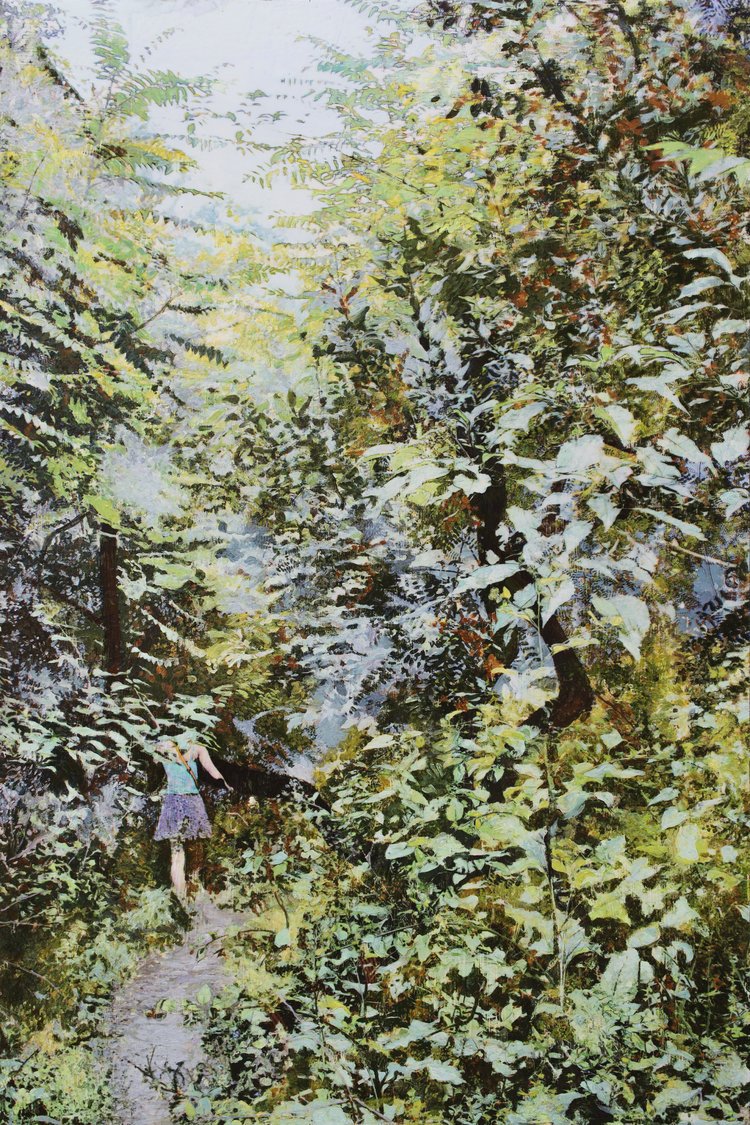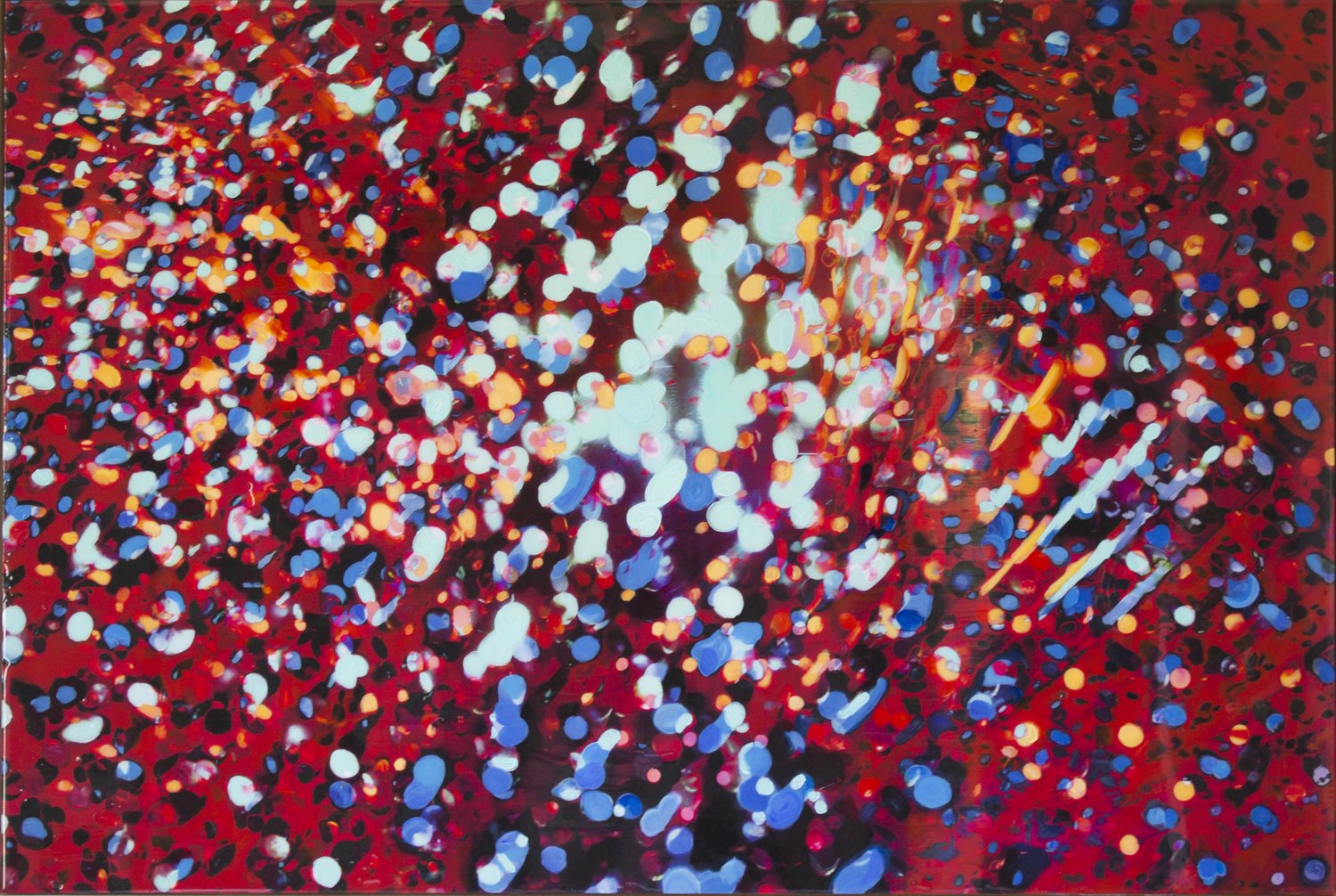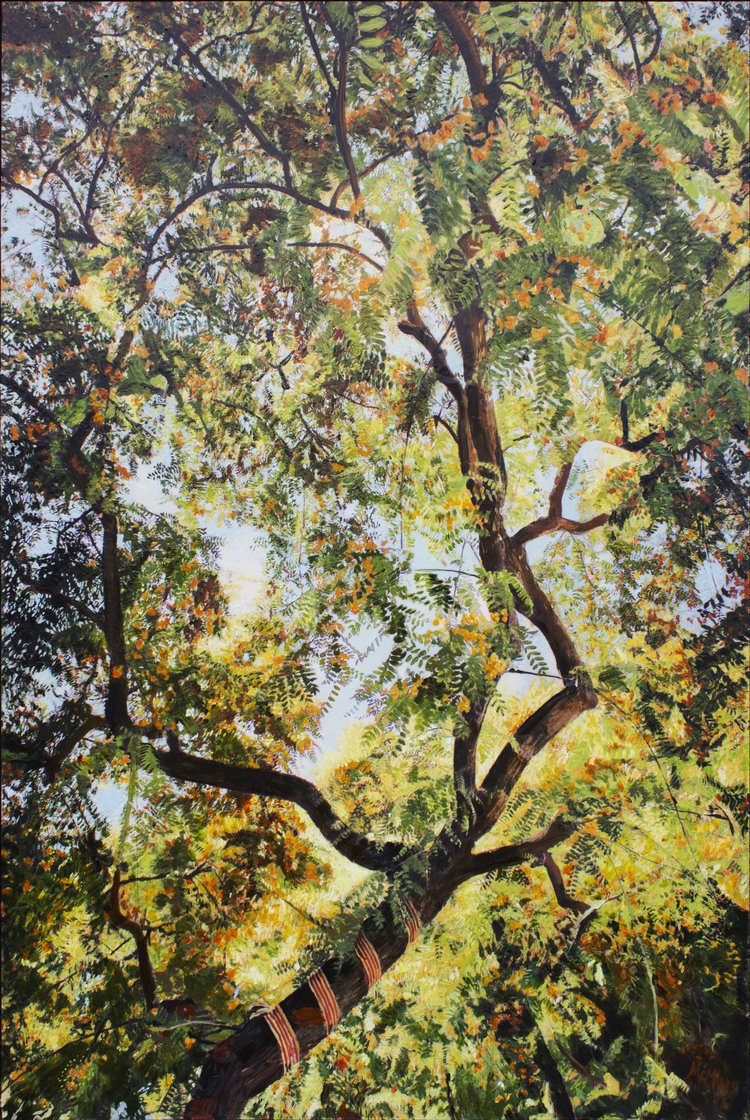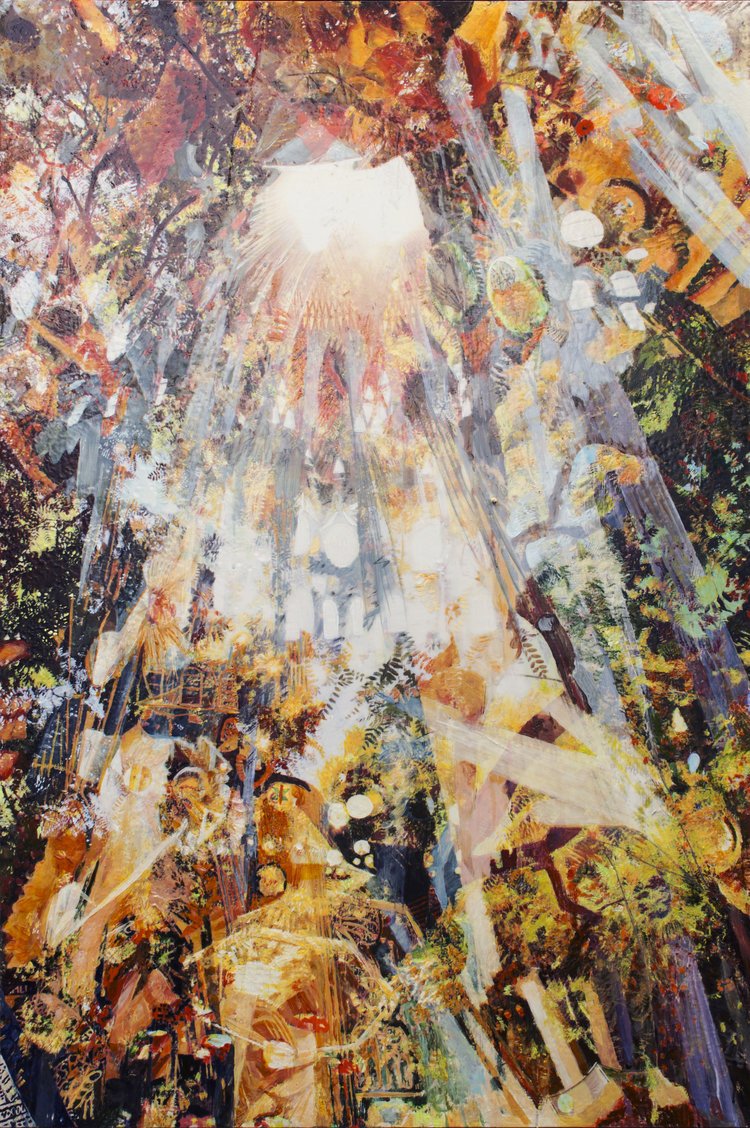By Connor simons
Poet Connor Simons interviews Minneapolis-based artist Connor McManus, whose painting “Wandered River” appears as the banner image on the new Great River Review website.
Connor Simons: Could you perhaps give us an ‘elevator pitch’ version of your artistic ethos? What, if any, underlying goal do you have when producing different works?
Connor McManus: Good question. Big question. My work is pretty varied, from naturalesque landscapes to kaleidoscopic mandalas, but there is a metaphor that I ground my aesthetic and self-criticism by, and that’s music. My test is, ‘does this sing, does this resonate’. That works for me on an intuitive level but also in closer analysis – how do the rhythms relate to the overall movement in the composition, how do the colors harmonize to suggest one mood or another. A piece is successful (and it’s not like they all are – sometimes it takes me a year later to see why something just didn’t work) it succeeds like songs succeeds – all the parts are well balanced to create the desired overall impression.
I read in an Alain de Botton book on beauty – architecture in particular – that we surround ourselves with the things we don’t want to forget, the things that remind us of what we are missing in our lives. Sometimes I think of my pieces in those terms too, knowing that they will end up on my or someone else’s wall. Take some of my pieces that are of trees but completely recolored – edging into the abstract – I think I do that to make something familiar seem new again, to remind people that the most common aspects of our surroundings are astonishingly beautiful. Those familiar things are easy to ignore. Those tree pieces are reminders of how strange and unlikely trees actually are – and by extension how unlikely any of this actually is – being itself. How they operate is a little like how seeing the world on mushrooms helps remind you of the big picture – the world is temporarily retuned, like you might retune a guitar, and you see all of it again with a fresh perspective. I aim for my work to hint towards that, because we all get rutted into our day-to-day work and painful, small dramas. When I make my work, I try to re-inhabit the wonder with which we once regarded the world, and hopefully that comes across in the finished pieces.
CS: As just about any millennial-aged ‘creative type’ knows, it is ridiculously hard to make a living as a ‘pure artist’. Could you tell us about the relationship between commercialism and artistry in your own artistic practice(s) and development as an artist?
CM: Sure, and this ties into what I was just saying. I do view my work in the context of where it will be and who will be looking at it, and what positive impact it can have on that room, on those people. I make most of my living at an architecture firm, so I think like a designer too, where the art pieces are not the whole shebang, but just one component of a space with aims for the experience of the people in it. In New Orleans, where I lived for the past five years before moving to Minneapolis, I built a great relationship with a group, Where Y’art, which connects me with commercial buyers like the new hospitals which have been expanding since Katrina. They have commissioned a lot of my more natural work, and have bought prints and remarked giclees (a pretentious way to say prints on canvas with additional paint added). Sometimes they request that I make a new version of an old piece but in different colors (they can’t have the color red, or images of birds (for some reason birds are particularly morbid) on their walls). I think this type of commercial relationship is becoming more common for a lot of artists, but maybe if I were in New York or in some big galleries this would be a no-no, because the value of art is tied to exclusivity and some sacrosanct notion of artist as untainted by plebian desire for pretty decoration. But you look at that attitude from a moral perspective and it’s reprehensible. Insofar as I want people to gain something positive from my work, of course I would extend that to people who are in the unfortunate circumstances of sitting in a hospital waiting room. Otherwise, you sell a piece once, to the richest person you can find, and then they and their rich friends are the only people who ever appreciate the work. Also, because I design most of my work in photoshop, collaging and sampling from photographs, I have 20 alternate versions of every piece I make – they’re like B-sides or remixes. So I enjoy going back to old work and reworking for a particular need. If the piece can sing in its own right and be tuned to the key of a room, to function on the architectural scale, making a space beautiful in a place not normally associated with beauty, I think that’s a good thing.








CS: Obviously, Great River Review is primarily geared towards writers and poets. What intersections/relationships do you see between the written arts (poetry, nonfiction, and fiction) and visual arts (whether as a whole or in your own work)?
CM: Well there are a couple of intersections that I see there. First is, on the visceral level, in poetry and fiction in particular perhaps, writers can articulate aesthetic details in more depth and from more angles than can be gleaned from an image. They have recourse to layering in the other senses, concurrent thoughts and emotions, and associated memories, which taken all together form the aesthetic punch. A painting can show you the beauty of a flower, but writers can put you right in the mental space from which that beauty springs forth, so you can share the experience of someone really being moved by simple, persistent beauty. That’s recourse to drama. Maybe your mom passed away a year ago, and she was a gardener, and you’re here trying to keep the damn weeds from taking over your patio, and the dirt is under your fingernails, the wriggle of an earthworm scares you for a second, the sweat is on your brow, clothes sticky, scent of cut grass from your neighbors’ lawns, and while you sit here crouched and uncomfortable and sore and sad, you notice a flower that your mom told you about once sprouting up three feet away, and you move closer and admire it. There’s so much more context to layer in there than visual artists have at their grasp, although I think that’s why so many great paintings have an implied narrative built in. Take Japanese prints of mostly landscape, but somewhere in the middle-distance there’s a bridge and tiny figures walking across hastily through the rain. The beauty of the scene hits you with a whollop because there are those people in the narrative space, who have a past and a future, captured in this fleeting moment, their immediate motivation so clear and relatable. So, drama. We can hint at it, but you can work with it so much more to charge up those aesthetic observations with meaningful overtones.
I also do think drama has those same musical elements I was discussing earlier. It’s the layering of imagery, themes, plot, characters and their foils, and the structural rhythm at whatever scale – poem, chapter, or book - that function to me much like the different elements of a song or album. As the drama unfolds, those elements grow and interplay with each other, creating harmony or dissonance – rewarding the reader with a good balance between expectation and surprise. I think that musical element still applies, and is a good bridge metaphor between the two, because music shares literature’s narrative element, although music is typically more abstract. In visual art, that narrative or temporal dimension is compressed and flattened into two-dimensions on the canvas, and appears as abstracted visual movement or the suggestion of figurative drama like the people on the bridge.
CS: Do you have a mode or modes or visual art that you’re particularly drawn to? Why?
CM: Yes. In college, I started using Photoshop as a design tool to compose my work. Prior to that I would just paint abstractly and follow my whims until something looked finished. Although Photoshop gives me more control, it also gives me way more freedom, because I can quickly test things out (and hit undo!), manipulate images in many different ways, combine and layer things, sample, cut, crop, recolor, etc. Every medium has its motivation, though. Photoshop tends towards imagery that looks very digital and cold. So when I work with it I’m often pushing against that tendency, trying to make compositions that are painterly, and I usually resolve that through actually painting the composition (or painting over it) and using gestural intuition in the last 10% of the process. But by that time, I know what colors I want, I know the overall form and compositional intent. It’s like composing music on the computer and then re-recording with instruments after it’s all arranged. It feels right to me in terms of the tools available to produce what’s possible in this moment.
CS: What inspires you in your artistic practice(s)?
CM: Nature and music, mostly. I love the fractals in trees and other natural forms, how they reappear all over the world and are echoed in religious designs and architecture, how they are rooted in math, and likewise how musical harmonics break down into a pattern-language of vibration. I’ve spent some time investigating how to translate the basic thing that happens when music hits your ear – why do chords sound good, for instance, and the answer is basically that your earls like simple geometry of waves that sync up in a predictable way. The ratios of the wavelengths of the individual notes that compose chords sound good together because their wavelengths (or frequencies) lock together into repeated patterns, with simple ratios like 4:5:6. I’ve been playing with those properties in some of my recent work, trying to visualize this phenomena that humanity has appreciated with our ears forever. What fascinates me about this is that the same kinds of simple harmonics are appreciated in architecture and classical proportions. I think there is an element of beauty that is deep on the biological level – that these basic relationships and proportions resonate in the most basic sense with how nature patterns itself, and in turn – insofar as we register nature as beautiful - how we perceive our own creative abstractions to be beautiful. The closer they are to natural principles – the principles our ears naturally decode in music – the more universally beautiful the production is.
CS: Which visual artists working today, regardless of the medium, do you find particularly exciting?
CM: I really love Julie Mehretu. Her work is…well, I would say it embodies a lot of what I’ve already described. She makes large pieces that from afar are ethereal – like you’re looking at a cloud or an indistinct cacophony of imagination composed of many small, usually black or grey marks. As you get closer, the meta-image breaks down into smaller vignettes, you can see pieces of architecture or abstract mini-narratives dance across sections of the piece. And all the way down, down to each line or blot, she uses this great variety of mark-making, from anal architectural precision to painterly gesture. These marks are arranged in the Z plane on many layers of clear medium, so her work has a shallow depth that pushes some things back and brings others forward. It creates a sense of memory and association, newer ideas obfuscating or augmenting the previous. Looking at her work is like seeing a visualization of a memory palace – too vast and complex and personally encoded to understand, but at the same time familiar, and well, natural.
CS: Thank you for taking the time to have this interview with me, and thank you for contributing to Great River Review
Connor McManus’ work can be found at:
Website: connormcmanus.com
Online store: https://whereyart.net/artist/connor-mcmanus/315
Facebook: Connor Mcmanus Art
Instagram: @mkmanus
Want to read more great interviews? Great River Review now offers individual issues for sale. You can purchase a copy of GRR 71, GRR 70, or a number of other back issues, here.




